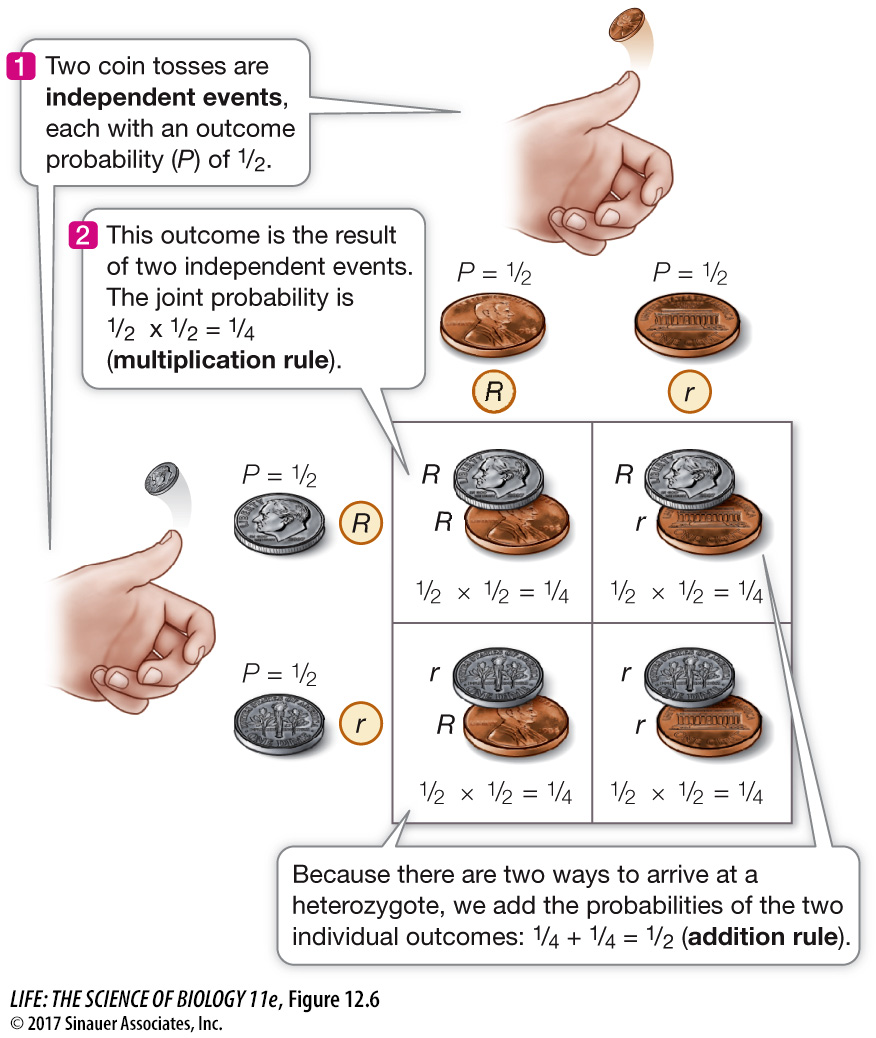Probability can be used to predict inheritance
One key to Mendel’s success was his use of large numbers of plants. By counting many offspring from each cross, he observed clear patterns that allowed him to formulate his theories. After his work became widely recognized, geneticists began using simple probability calculations to predict the ratios of genotypes and phenotypes in the progeny of a given cross or mating. They use statistics to determine whether the actual results match the prediction (as explored in the work with the data exercise on p. 243).
248
You can think of probabilities by considering a coin toss. The basic conventions of probability are simple:
If an event is absolutely certain to happen, its probability is 1.
If it cannot possibly happen, its probability is 0.
All other events have a probability between 0 and 1.
There are two possible outcomes of a coin toss, and both are equally likely, so the probability of heads is ½—as is the probability of tails.
If two coins (say a penny and a dime) are tossed, each acts independently of the other (Figure 12.6). What is the probability of both coins coming up heads? In half of the tosses, the penny comes up heads, and in half of that fraction, the dime comes up heads. The probability of both coins coming up heads is ½ × ½ = ¼. In general, the probability of two independent outcomes occurring together is found by multiplying the two individual probabilities (the multiplication rule). The multiplication rule can be seen in the results of a monohybrid cross (see Figure 12.1). After the self-

Probability can also be used to predict the proportions of phenotypes in a dihybrid cross. Let’s see how this works for the experiment shown in Figure 12.4. Using the principles we just described, you can calculate the probability of an F2 seed being round. This is found by adding the probability of obtaining an Rr heterozygote (½) to the probability of an RR homozygote (¼): a total of ¾ (the addition rule). By the same reasoning, the probability that a seed will be yellow is also ¾. The two characters are determined by separate genes and are independent of each other, so:
The joint probability for both round and yellow is ¾ × ¾ = 9⁄16.
What is the probability of F2 seeds being both wrinkled and yellow? The probability of being yellow is again ¾; the probability of being wrinkled is ½ × ½ = ¼, so:
The joint probability for both wrinkled and yellow is ¼ × ¾ = 3⁄16.
By the same reasoning:
The joint probability for both round (¾) and green (¼) is also 3⁄16.
Finally:
The joint probability for both wrinkled and green is ¼ × ¼ = 1⁄16.
Looking at all four phenotypes, you can see that they are expected to occur in the ratio of 9:3:3:1.
A Punnett square or these simple probability calculations can be used to determine the expected proportions of offspring with particular phenotypes. In the dihybrid cross discussed above, about one-